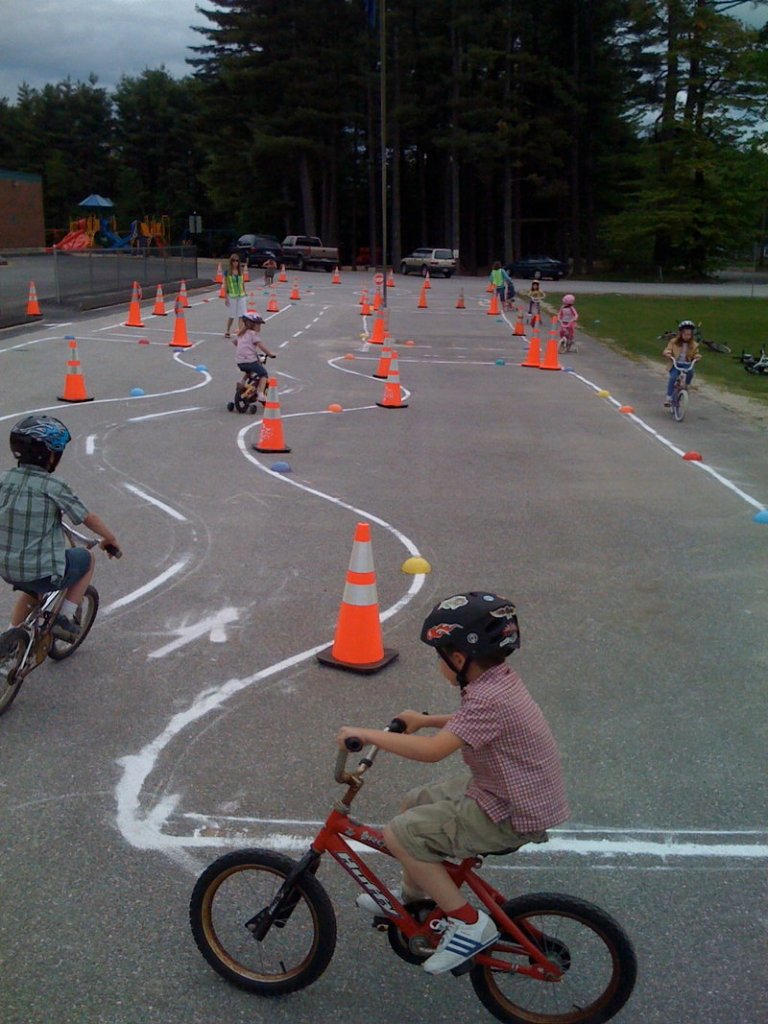A co-worker recently shared with me the story of a bicycle outing with her young daughter that turned painful — for Mom.
In an effort to avoid a collision when her child slowed significantly while chatting away, Mom hit the soft sand at the edge of the street where they were riding, didn’t get out of her pedals quickly enough and went down hard. Daughter coasted on unaffected, but the experience prompted Mom to suggest that some advice for cycling with kids might make good subject material for this column.
Happy to help. And so are Jim Tasse, the director of education for the Bicycle Coalition of Maine, and Darcy Whittemore, coordinator for the Safe Routes to School Program through MDOT and BCM. We all got together on a phone chat and they provided some great tips both for getting children comfortable on a bike and for helping parents stress less while on a family bike ride.
According to Tasse, safe, fun biking starts with the right bike. One of the biggest mistakes a parent can make is to buy a child a bike that’s a little bigger than it should be so they can grow into it. A bike is a good fit if you can stand over it with your feet flat on the ground without the frame touching your body. Expecting a child to ride a bike that’s too big may result in frustration, because the bike is too big to handle correctly, or injury.
“That experience can make a kid think they’re not really sure they want to be biking,” Tasse said.
Another key in getting kids started is helping them gain confidence in their abilities in controlled situations. Because the age at which children master their bikes varies — some as young as 5 may be adept on two wheels while Tasse admits he wasn’t able to balance until around age 10 — training wheels can be a young biker’s best friend. (And their parents’, too.)
“They enable a kid to get the sensation of handling a bicycle,” Tasse said. He suggests the training wheels should be installed by someone who knows a little about bike mechanics, and recommends that when the child begins to demonstrate a little more skill with the bike the training wheels be raised off the ground in small increments. “There may be more wobble side to side,” he said, “but if the bike tips a bit they’re still there to catch the kid.”
When starting out, children should ride in places that are free of traffic — empty parking lots, skills courses at bike rodeos, off-road trails or even an agility course parents can set up in their own driveway. (Visit www.bikemaine.org for info on the Celebrate Portland Festival rodeo on July 7.) In addition to showing they can balance the bike, parents also should be comfortable with their child’s ability to apply the brakes.
Practice is important, and Tasse and Whittemore suggest it is OK to do that on sidewalks, with certain guidelines. For example, if a parent is with a child who is biking on a sidewalk, the parent should either be walking next to the cyclist or riding on the road (with the flow of traffic) next to the child. The child should yield to pedestrians on the sidewalk and be aware that every driveway that crosses the sidewalk is an intersection.
“I can’t emphasize the point strongly enough about driveways,” Whittemore said. “People don’t pay attention.”
When children show they can control their bike and understand basic rules like stopping at all intersections and calling out to all pedestrians or cyclists they will pass on the right, they’re likely ready for a family ride. Tasse and Whittemore suggest a child’s first outing be on a trail like the South Portland Greenbelt or Eastern Trail. And though road riding allows for speed and smoothness, many kids are attracted to the adventure that is off-road riding. Trail riding also increases handling skills more quickly.
If two adults are present, one should ride at the front of the group and the other at the back. If only one parent is riding, he or she should be at the rear of the group, about 10 feet back. That distance should give the adult enough time to sprint to the front of the group if needed because the child’s decision-making skills may not yet be fully developed.
“They may see an obstacle and only think of that obstacle and not the car that’s passing them on the left,” Whittemore said. She also suggests guidelines be set, including the order the group of cyclists will stay in and the distance children are allowed to pedal ahead of others in the group.
Parents also can take measures to make things safer for themselves while riding with their children.
“For parents, I’d rather they be on a mountain bike rather than clipped in on a road bike when dealing with a small child,” Whittemore said. “And parents should model good behavior and the rules of the road. A child has to wear a helmet under the age of 16, and parents should as well to model good behavior.”
Parents, Tasse said, should be watching for signs of fatigue or difficulty with the bike. Rides with young children should be kept to short distances, with water and snacks available. Frequent stops for off-bike exploring are also important.
“This should be about fun more than anything else,” he said. “Don’t make it a death march, make it let’s go have some fun outside.”
Karen Beaudoin can be contacted at 791-6296 or at: kbeaudoin@mainetoday.com
Send questions/comments to the editors.



Comments are no longer available on this story